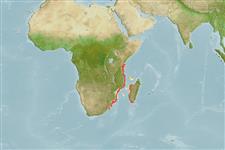Common names from other countries
Environment: milieu / climate zone / depth range / distribution range
Οικολογία
; εύρος βάθους 180 - 750 m (Ref. 106911), usually 400 - 500 m (Ref. 106911). Tropical, preferred 26°C (Ref. 107945); 3°S - 33°S, 31°E - 46°E (Ref. 4)
Southwest Atlantic and Indo-West Pacific: from Kenya to Natal.
Length at first maturity / Μέγεθος / Βάρος / Age
Maturity: Lm 4.9, range 3 - ? cm Max length : 20.5 cm TL αρσενικό/απροσδιόριστο; (Ref. 122061); 20 cm TL (female)
It has a maximum total length of 20.5 cm (male) and 20 cm (female); and carapace lengths of 4.5 to 8.8 cm (male) and 3.7 to 8.3 (female). Minimum depth range from Ref. 122059. Occurs at depths from 200 to 750 m, but most common between 400 and 500 m (Ref. 4). Occurs along the edge of the continental slope on soft muddy substrata (Ref. 106911).
Life cycle and mating behavior
Γεννητική Ωρίμανση | Αναπαραγωγή | Γεννοβολία | Αβγά | Γονιμότητα | Προνύμφες
Ovigerous females between December and June (Ref. 4).
Holthuis, L.B. 1991. (Ref. 4)
IUCN Red List Status (Ref. 130435)
CITES status (Ref. 108899)
Not Evaluated
Not Evaluated
Human uses
αλιεία: Εμπορικό(ά)
FAO - αλιεία: landings | FishSource | Η θάλασσα γύρω μας
Εργαλεία
Περισσότερες πληροφορίες
Age/Size
Αύξηση
Length-weight
Length-length
Μορφολογία
Προνύμφες
Αφθονία
Διαδικτυακές πηγές
Estimates based on models
Preferred temperature
(Ref.
115969): 10 - 12.3, mean 11.4 (based on 9 cells).
Ελαστικότητα
Υψηλό, ελάχιστος χρόνος για διπλασιασμό πληθυσμού < 15 μήνες (K=0.45-0.48).
Vulnerability
Low vulnerability (11 of 100).
